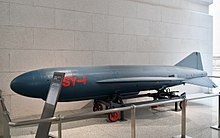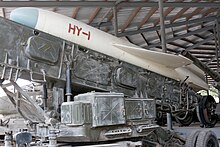Silkworm
Silkworm (English for silkworm) is the NATO code name of the SY series and HY series. These series were the first Chinese anti-ship missiles . They were derivatives of the Soviet P-15 Termite .
SY series
The SY series were developed from the Soviet P-15 Termit. They can be launched from small high-speed rocket boats with limited on-board electronics. China struggled to make these missiles compatible with the more complex systems of larger warships. Therefore, the HY series were developed for larger warships, but the SY series continued to be produced as armament for missile speedboats and as a cheaper export variant.
SY-1
The SY-1 is the first original Chinese version of the Soviet P-15 Termit missile. The difference between the P-15 Termit and the SY-1 is that the unreliable aneroid altimeter on the SS-N-2 Styx has been replaced with a much more reliable radar altimeter . As a replacement for the SY-1, the SY-1A was designed by Ping Lisheng. It bears the NATO code name CSS-N-1 "Scrubbrush".
SY-2
The liquid rocket engine was quite dangerous and unreliable, so a solid rocket engine was developed. This made it possible to reduce the size and weight of the missile and to increase its range. The weight of the warhead has also been reduced, but its effectiveness has been increased. An improved version of the SY-2 is called the SY-2A.
HY series
HY-1
The HY-1 was given two different NATO code names: CSS-N-2 “Safflower” for the ship-to-ship version and CSS-C-2 “Silkworm” for the ground-to-ship version.
The HY-1J was initially intended for use on the Type 051 destroyer, but the turmoil of the Cultural Revolution extended its development into the 1980s. As a result, the Type 051 destroyers were used in the Pacific without anti-ship missiles.
variants
- HY-1
- The basic variant developed from the SY rocket, which was only used in small numbers as a surface-to-ship rocket for evaluation. It was not produced in series and was replaced by the HY-1J.
- HY-1J
- The ship-to-ship variant for the Type 051 DDG destroyer.
- HY-1YES
- The improved ship-to-ship variant.
- HY-1A
- The ground-to-ship variant based on the HY-1JA.
- HY-1B
- The target imaging drone for testing HQ-2A SAM.
- HJ-1YB
- The target imaging drone for testing HQ-61 SAM.
HY-2
The HY-2 and HY-1 are almost identical, but the HY-2 is longer. The HY-2 has a radome, delta wing in the middle and is equipped with a liquid rocket engine. The HY-2 is launched from the mainland. The flight altitude is 1000 m during the first flight phase. During the cruise it is reduced to 300 to 100 m. When approaching the target, the altitude is reduced to 8 m until the missile hits the target. Due to their size, there is no ship-to-ship variant. The HY-2 was exported in large numbers to the Middle East, where it is known as the Silkworm .
variants
- HY-2
- The basic radar-guided surface-to-ship missile that is an evolution of the HY-1.
- HY-2A
- The infrared-guided variant.
- HY-2AII
- The improved variant of the HY-2A.
- HY-2B
- The improved radar-guided variant with the monopulse radar seeker.
- HY-2BII
- The improved variant of the HY-2B with a newly developed radar seeker.
- C-201
- Export name of the air-to-ground variant.
- C-201W
- Variant with turbine air jet engine and increased range, only for export.
Web links
Individual evidence
- ↑ ( page no longer available ) Archive link ( Memento from October 19, 2008 in the Internet Archive )




